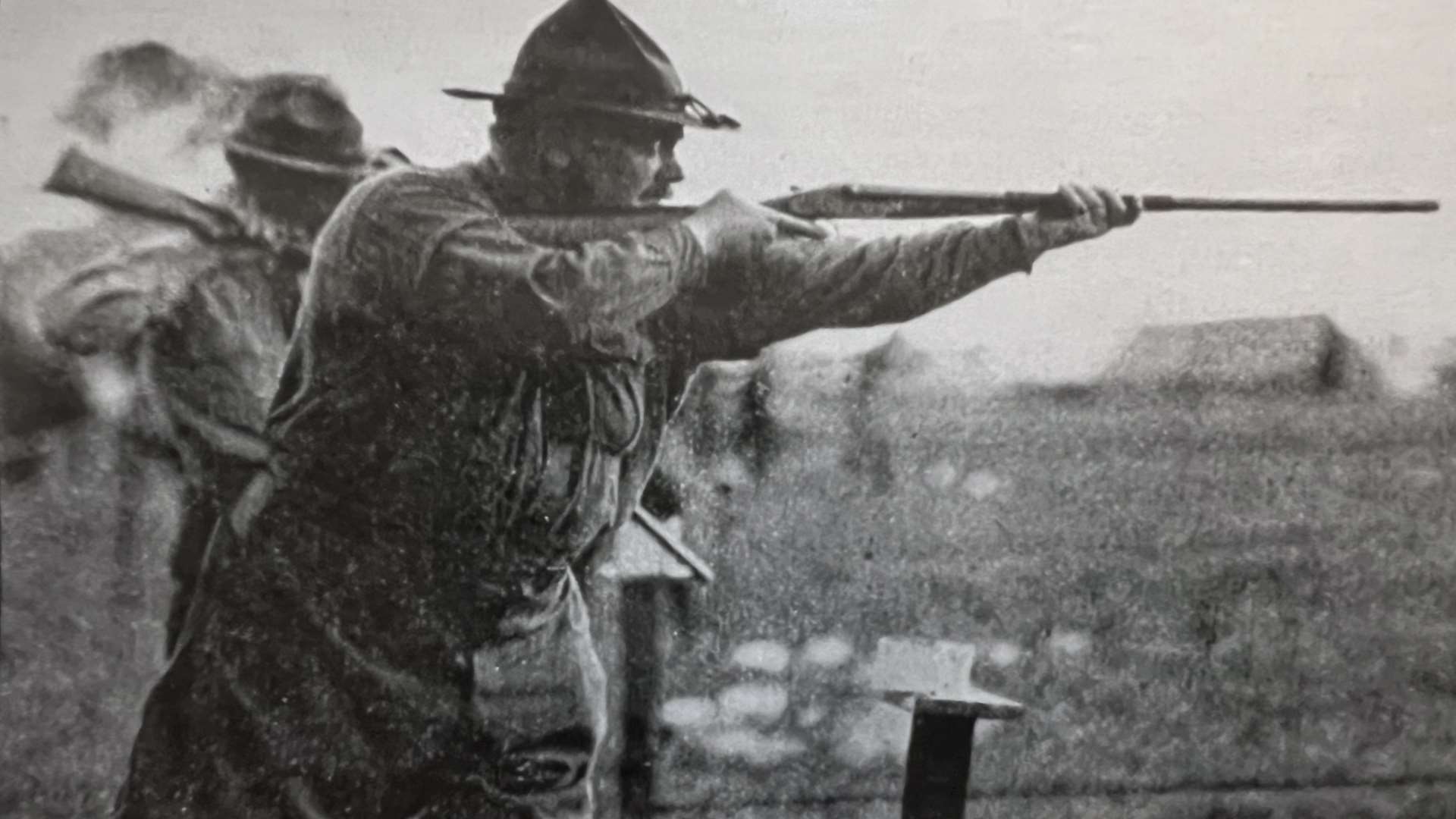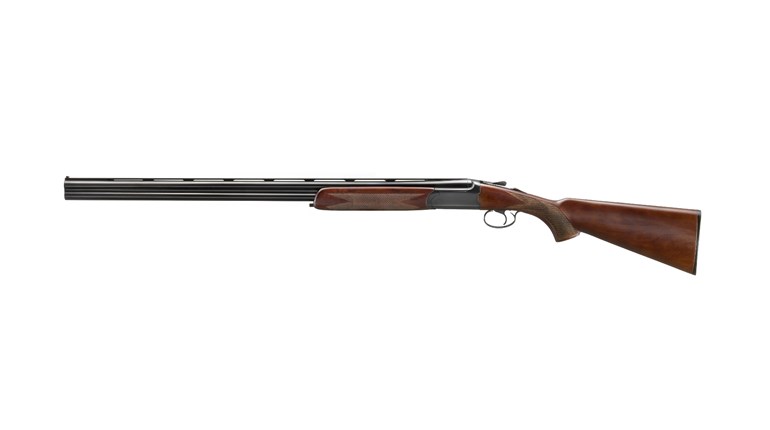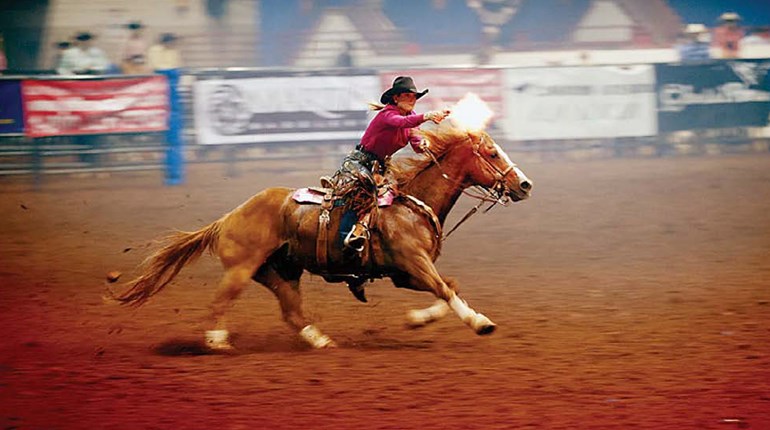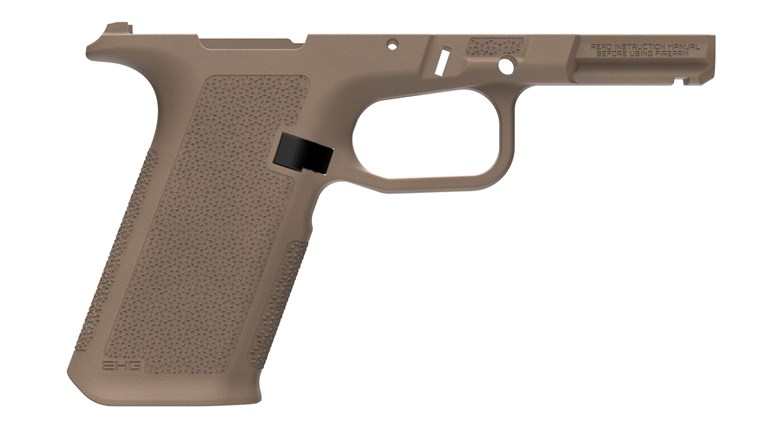
The below is an excerpt from the 1978 book “Olympic Shooting,” written by Col. Jim Crossman and published by the NRA.
The Clay Target Shotgun Event
By Colonel Jim Crossman
While international skeet is much like U.S. skeet, the international clay bird event differs markedly from any U.S. shooting game. It requires a different field layout and, up to about 18 years ago, there was not a single international clay bird field in this country.
Both American and international trap came from the same parents, but they separated along the way. According to some English authorities, clay bird shooting can be traced back to popinjay shooting, mentioned by Homer in the Iliad. In popinjay shooting, a stuffed bird was placed on the top of a pole, or a live bird was tied to the top of a pole with a short string to provide a target for an archery contest.
It was a long road from there to pigeon shooting, but the logical steps can be traced something like this: Two hunters argued about their shooting ability and made a bet. They decided hunting conditions were too variable from shot to shot. So, they arranged to collect a number of birds and have them thrown in the air on call and that was the start of competitive bird shooting.
Although various kinds of birds have been used, the pigeon turned out to be the most practical. It was not hard to raise (many would be caught around barnyards) and it was a tough, difficult target. Among the best pigeons was a type known as the Blue Rock. Because uniformity of release was sought, the ability of the thrower was important. To avoid this difficulty and other problems, birds were put in traps and a cord was pulled to open the trap and let the bird out. The shooter still calls “pull” to have the clay "bird" thrown from the “trap,” and calls “dead” or “lost” for a hit or miss.
Although the rules varied from place to place and time to time, it was common to use five traps. The shooter did not know which trap would be pulled when he called. When clay birds became popular, the same five-trap layout was used.
Inanimate, breakable targets became popular in the late 1800s for some purposes. The great exhibition shots, such as Dr. Carver, Chevalier Ira Paine and Capt. A. H. Bogardus, used glass balls extensively. Much development work was done on the traps and they became very excellent and quite ingenious, throwing at varying angles, throwing doubles and even having repeating mechanisms.
The glass ball developed from a simple clear hollow ball to colored glass, with the center often filled with feathers to make a break more spectacular. Glass was a nuisance and various other brittle materials were tried at one time or another. They were only moderately successful, though, and largely fell by the wayside with the invention and development of the Ligowsky trap and the clay bird, which is neither clay nor a bird.
The clay bird, clay pigeon, Blue Rock, White Flyer or clay—whatever it is called—is now standard throughout the world, differing only in slight details. It is saucer-shaped, about 4¼ inches across. It is made of tar and limestone, melted and mixed together and pressed in a mold. It may be left unpainted in its natural black color, or it may be partially or completely painted white, yellow, orange or another color.
Some time ago I got involved in a shotgun shooting match in Korea, where we had about the freshest birds I’ve ever encountered. In a little gully less than 100 yards from the range, a couple of Koreans had a fire going under a big kettle. Periodically they would dip some of the mixture out of the kettle, put it in the bottom half of a mold, run the top section of the mold down, wait a few seconds, and there was a nice, fresh bird. Usually the bird was hand painted, with a couple of coats of white paint on the top. In this country, clay birds are turned out by automatic machinery in great numbers.
The clay bird should be carefully designed so that it will readily and visibly break when hit by one or two pellets, while at the same time withstanding a reasonable amount of rough handling in shipping and being thrown from the trap. In American trapshooting the bird is thrown about 50 yards—not more than 52, while in the international shoots the trap must be set to throw the bird 75 meters (82 yards) plus or minus vie meters. A bird which will just stand the throwing force of the American trap will break in the international machine. Birds designed for international shooting are stronger to withstand the increased throwing force; consequently, they are also more difficult to break with a shot charge.
Clay bird shooting in this country has taken many forms, but with the development of the auto-angling trap it settled into the trap game so popular today. A single trap is mounted in a protective house. With the trap as a center, an arc of a circle 16 yards in radius is drawn behind it and five shooting stations are marked out, three yards apart. Squads of five men are used, each shooting five shots at each of the five stations. The shooter can put his gun to his shoulder and when he calls for the bird it is thrown immediately. The vertical angle of the trap is fixed, but the lateral angle is automatically changed with every shot, to include an angle of about 45 degrees. Shooters are often divided into classes, based on past shooting, for purposes of splitting up the prizes.
Another form of American clay bird shooting is handicap, in which a competitor shoots from 18 to 27 yards distance from the trap, depending on past performance. In both events, 16-yard and handicap, only a single shot is permitted at each bird.
In the third form of U.S. shooting, two clay birds are thrown simultaneously and two shots are fired. Conditions are much the same as at 16-yard singles, except that the lateral angles of both birds are fixed, and thus the flight paths of both birds are known in advance.
The international form of trapshooting also uses a clay bird and a spring-powered trap, but there are more differences than similarities to the U.S. game. International trap uses a long pit with 15 traps mounted in it, grouped in threes. Distance between the center trap of each group is about four meters. Shooting stations are established 15 meters (16½ yards) behind each group of traps.
In each group of three traps, the right trap throws to the left, the left trap throws to the right, and the center trap throws generally straight ahead. The angles can be up to 45 degrees each side of center or a total of 90 degrees. In addition, the traps are adjusted to give varying vertical paths; at a distance of 10 meters (11 yards) from the trap, the birds will vary from one to four meters high. Traps are set practically below ground level.
The international, therefore, gives wider lateral angles combined with great variation in vertical angles for a wide variety of targets, varying from a daisy-cutter to a high, towering bird, with a variety of lateral angles. In addition, the bird is thrown more than 50 percent farther than in the U.S. game, which means it is much faster and the bird itself must be stronger to withstand the throwing force. All this adds up to a very tough game.
The shooter is permitted two shots, with no penalty, just as long as he breaks the bird. The shooter can hold his gun at his shoulder when he calls, but he has to move to another shooting station after each shot; usually a six-man squad is used, since someone is always in the process of making the long trip from station five around to station one.
In important competitions a special trap-selecting device is used. This picks an unknown trap each time, but is cunningly worked out inside so that each shooter gets the same number of birds from each trap, and therefore the same number of birds of various angles and heights.
The international trap game is much more demanding than the American sport, and scores are lower. At least partly for this reason, American shooters have never taken to it. Although this general trap setup has been used internationally for well over half a century, until about 18 years ago there was not a single international field in this country. Even now, there are only a few active fields. There are hundreds of fields set up for American trap scattered all over the country; but even the great home layout of the Amateur Trapshooting Association at Vandalia, with its mile-long layout of over 72 fields all-in-a-line, does not have a single international field.
In addition to the more difficult birds and the inability to “get ‘em all” each round, there are economic reasons for the lack of popularity of the international game. The big pits are expensive to build. They are usually concrete, more than six feet high, 10 feet wide and about 65 feet long. After this monster, with its draining, wiring and entrance steps is built, it must be fitted with 15 traps and an elaborate trap release mechanism.
The fancy layouts use a voice release, with a microphone in front of each shooting station. Microphones are normally shut off until a shooter steps up ready to shoot, when the puller turns that microphone on. The shooter’s call releases the bird, usually with a slight delay, to duplicate conditions where the puller actually releases the bird.
In addition, it is necessary to have at least three and more likely five trappers in the pit to service the traps, plus a puller. There is no doubt that this is an expensive game.
The international shooters have a scheme which creates spectator interest. A big flip board has counters on it for each bird and for each shooter. As each shot is fired, a counter opposite the shooter’s name is slid to the other end of the board. But when he misses, the counter is turned over, to disclose an annoyingly conspicuous color and at the same time the referee honks a little horn, so that everyone can share in the shooter’s grief. It is easy to glance at the board and see how everyone in the squad is getting along. This same scheme is used both in the clay pigeon and skeet events.
A modified style of clay bird shooting, somewhere in between the American and the international form, is gaining some popularity. In addition to the automatic lateral angling device on the U.S. trap, an automatic vertical angling mechanism can be built in, so that the trap changes both vertical and lateral angles for each shot. This gives something closer to the international, and if the lateral angles are widened to 45 degrees and the trap springs screwed up to throw the birds harder, a reasonable approximation of the international field can be obtained. A few such traps were installed cautiously at Vandalia a few years ago and were so popular that more were later added. Hopefully, this modified game will grow. Until American shooters get many more international fields or many more modified fields, the United States is going to be short of talent in international trap competition.
The American shooter, accustomed to breaking his 24 or 25 in domestic shooting, is due for a rude shock when he first tries an international round. The wide lateral angles, the varying vertical angles, and the fast birds throw the shooter’s timing and lead off completely, and he probably does not think about using that lifesaving second shot. But the principles of the two games are not too different, and a good shot on American birds should become a good shot on international birds with some practice.
Some American equipment is not suitable for international competition. The single-barrel trap gun is unsuitable, since the second shot is needed. The pump gun is hardly ever seen in international competition and the autoloader is not much more popular. The over-and-under is by far the most widely used. It permits slightly different choke for the first and second shots and does not heat up as quickly as the single-barrel gun. Even so, some shooters often pause and run a little cooling water through the barrels between shots on a hot day.
In American trap the bird is always rising at a fixed angle, so the trap gun is usually set to shoot high. This permits the shooter to hold under the bird and never lose sight of it. The international bird varies in vertical angle from a grass skimmer to a high, climbing bird. The international gun, therefore, is usually stocked to place the charge more closely on center than the U.S. gun. International loads are heavy; with two shots available, it is necessary that the stock fit the shooter very well or he will soon be pounded sore.
There is no restriction on powder loads for international clay bird shooting but the shot load is limited now to 1⅛ ounces of shot. The international loads give considerably higher velocity, the standard being 3¼ dram-equivalent and running up to 3¾. Dick Loffelmacher, the U.S. shooter who won second in the 1967 World Championships, used 3¼-1¼-8 for the first shot and the potent 3¾-1¼-7½ for his second, shooting nickel-plated shot in both cases.
This brings up the matter of the second shot. It makes no difference on the score sheet whether the bird is broken on the first or the second shot. As a rule, the first shot is taken when the bird is about 35 yards away. If the shooter does not promptly make the second shot, the bird is out of range. Some shooters, like the 1967 champion, Guy Renard, rarely use the second barrel and then only following a clear miss. Other shooters, like Loffelmacher, usually fire the second at any visible piece they can see. This keeps them in training so they do not get such a rude shock on those occasions when the first barrel fails to do its job. In training, exceptional shooters sometimes use a first cartridge loaded with dust shot so that even a perfect hold will not break the bird, enabling them to get good second-barrel practice.
The general principles of international clay bird shooting are much the same as American trapshooting but there are some detailed differences:
- The gun must be stocked-to-fit to avoid pounding the shooter and to shoot close to center.
- The shooter holds on the trap house when he calls, so a bird does not sneak away.
- The shooter positions his forward foot to give a smooth swing in either direction, because wide angles are to be expected at any of the five stations.
On an international field, the shooter will find five lines or other marks on the top of the trap house. These indicate the center trap of each of the groups of three. When he steps up to the first station, the shooter knows that the bird will be thrown from one of the left group of three and he uses the left marker on the trap house as a guide for his initial hold. Since this bird is going to be flying much faster than the U.S. bird and at such wider angles, the shooter cannot be relaxed and leisurely. He must step up, position his foot correctly, load two shots, put the gun carefully to the shoulder and prepare to swing out immediately as soon as the bird appears.
Where to hold on the bird depends on the shooter’s technique of shooting, but generally he should not be too far ahead. By the time of the second shot, the bird will be way out, and often dropping, possibly requiring the shooter to hold a bit lower. The fundamentals of breaking birds can be learned in the U.S. trap game, but once the shooter becomes reasonably good it is time to switch over; otherwise, there will be too many bad habits to unlearn.
There may be trouble in finding a real international field on which to practice. But there are steps to take that will help on the American field. The operator can screw up the trap spring as far as it will go and still not break too many birds. He can increase the lateral angle as much as possible, and practice using two shots; better yet, he can get one of the modified traps or modify one to give the variable vertical angle. With these changes, a tight spring and wide lateral angles, the shooter is in fair shape for practice. He ought to change stations after every shot to get a new start for the next shot. All guns must be open when moving between stations, except that they must be open and also unloaded during that long walk from station five to station one. This is one reason that the autoloader or pump gun is not too popular—the nuisance of having to unload it.
While American trap will give training and experience in competition, a shooter must practice international trap in order to become good at it. There are enough differences to require considerable training in switching from the U.S. game to the international. But once a shooter gets the feel of the international game, the U.S. style will lose some of its interest. The international game is tough, fun to shoot and a great challenge.



































